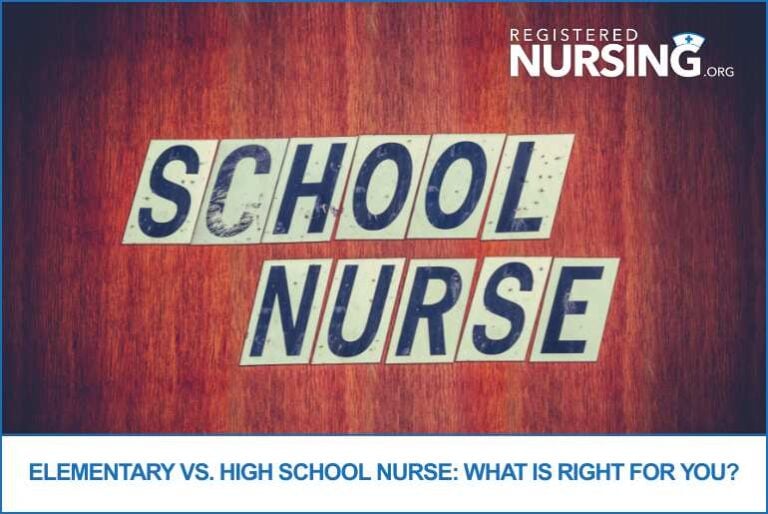Elementary vs. High School Nurse: What is Right for You?
- Core Responsibilities: Elementary vs. High School Nurse
- Side-by-Side Comparison of Key Responsibilities
- Skill Sets and Personal Qualities for Each Role
- Work Environment and Daily Routine
- Advantages and Challenges
- Real-World Context: Case Examples
- Educational Requirements and Certifications
- Salary and Job Outlook
- Questions to Help You Decide
- Take the Next Step Toward School Nursing
- Sources
- Latest Articles & Guides

Each day, over 56 million students attend U.S. public and private schools, and with them come diverse health needs that require skilled nursing care (National Center for Education Statistics). School nurses play a vital role in ensuring student safety, supporting chronic condition management, and promoting healthy development. But when choosing between working in an elementary or high school, nurses must weigh factors like age group preferences, scope of practice, and personal strengths.
If you’re exploring a shift into school nursing or beginning your career in this specialty, understanding the unique aspects of elementary vs. high school nurse roles is essential. This guide will walk you through the responsibilities, skill sets, work environments, and more, helping you make an informed and fulfilling decision about your nursing path.
Core Responsibilities: Elementary vs. High School Nurse
Understanding the day-to-day duties of each role is key to identifying the right fit for your nursing career. While both roles focus on student health, the age-specific needs differ significantly.
Elementary School Nurse
Elementary school nurses work with students aged 5 to 11, focusing on preventive care, early detection of health issues, and supporting child development. Their responsibilities include:
- Administering first aid for minor injuries
- Managing chronic childhood conditions (e.g., asthma, diabetes)
- Conducting vision, hearing, and scoliosis screenings
- Educating on hygiene and basic health practices
- Communicating regularly with parents/guardians
- Ensuring immunization compliance
- Monitoring outbreaks (e.g., lice, pink eye)
Because younger children often struggle to express symptoms, elementary nurses must rely on observation and gentle communication.
High School Nurse
High school nurses support adolescents aged 14 to 18 and face a broader range of health needs. This includes physical, emotional, and behavioral care, as well as education around complex topics:
- Responding to sports-related or urgent injuries
- Addressing mental health issues (e.g., anxiety, depression)
- Offering sexual health education and support
- Managing chronic conditions and medications
- Supporting students with substance abuse or eating disorders
- Collaborating with counselors on behavioral plans
This role often requires more advocacy, confidentiality, and crisis intervention than in elementary settings.
Side-by-Side Comparison of Key Responsibilities
| Responsibility | Elementary School Nurse | High School Nurse |
| Age Group | 5–11 years old | 14–18 years old |
| Common Duties | Screenings, minor injuries, hygiene | Mental health, chronic illness, education |
| Health Education Topics | Handwashing, nutrition | Sexual health, substance use, stress |
| Parent Involvement | High | Moderate |
| Emotional and Behavioral Support | Emerging needs | Complex issues |
| Emergency Response | Low frequency | Higher frequency (sports, acute illness) |
Skill Sets and Personal Qualities for Each Role
Choosing between these nursing roles also means considering your strengths and personality. Each setting demands a unique combination of soft skills, clinical knowledge, and interpersonal strengths.
Skills Suited for Elementary School Nurses
Elementary settings are ideal for nurses who thrive in nurturing, routine-focused environments. You may excel here if you have:
- High levels of patience and empathy
- Strong communication with caregivers
- Keen observational skills
- Creativity in health education
- Comfort handling emotional children
Skills Suited for High School Nurses
High schools offer a fast-paced, often unpredictable setting that requires maturity and adaptability. Nurses in these roles benefit from:
- Strong adolescent communication skills
- Mental health awareness
- Firm ethical boundaries around confidentiality
- Comfort with sensitive discussions
- Readiness for crisis response and counseling
Work Environment and Daily Routine
A typical day in either setting can vary widely. However, understanding what a “normal” day might look like can help you visualize which job aligns with your preferences.
A Day in the Life of an Elementary School Nurse
Mornings often start with routine medication administration. As the day progresses, expect a high volume of visits for:
- Stomach aches and mild injuries
- Anxiety about school separation
- Preventive screenings
You’ll also spend time talking with parents and collaborating with teachers on care plans and interventions.
A Day in the Life of a High School Nurse
High school nurses often begin with checking in on students managing chronic illnesses. The rest of the day may involve:
- Treating injuries from gym or sports
- Meeting with students on mental health issues
- Conducting one-on-one health counseling sessions
- Supporting staff in behavioral interventions
This role requires flexibility and often involves emotionally charged interactions.
Advantages and Challenges
Understanding the pros and cons of each role can clarify which setting matches your lifestyle and professional goals.
Elementary School Nurse: Pros and Cons
Advantages
- Early influence on student health habits
- Structured, predictable issues
- Strong parent-teacher collaboration
- Joyful, nurturing work environment
Challenges
- High volume of minor complaints
- Limited verbal communication from young students
- Emotional fatigue from seeing distressed children
High School Nurse: Pros and Cons
Advantages
- Broad impact on adolescent health
- Varied, stimulating caseload
- Deeper student-nurse relationships
- Opportunities to teach autonomy and responsibility
Challenges
- Navigating complex emotional and social challenges
- Confidentiality-related legal and ethical dilemmas
- Exposure to high-risk behaviors and crises
Real-World Context: Case Examples
Case: Jessica, RN in Elementary School
Jessica transitioned from pediatric nursing to a K-5 school. She enjoys using her teaching skills to promote hygiene and preventive care. She finds it rewarding to be a comforting presence for anxious kindergartners.
Case: Mark, RN in High School
Mark, a former ER nurse, now supports a large high school. He finds purpose in helping students manage anxiety and navigate safe relationships. His background in emergency care helps him handle sports injuries and acute crises.
Educational Requirements and Certifications
Whether you’re working with children or teens, school nurses need foundational education and licensure. Here's a look at typical qualifications:
| Requirement | Elementary School Nurse | High School Nurse |
| RN License | Required | Required |
| BSN Degree | Strongly preferred (AACN) | Strongly preferred (AACN) |
| Pediatric Experience | Highly beneficial | Optional |
| Mental Health Training | Optional | Highly recommended |
| School Nurse Certification | May be required by district (NASN) | May be required by district (NASN) |
Additional certifications like Pediatric Advanced Life Support (PALS) and Mental Health First Aid can enhance your resume and readiness.
Salary and Job Outlook
School nurse salaries are relatively consistent across grade levels, though variations exist based on district, location, and experience.
Demand is growing due to heightened awareness around student mental health and school safety.
Questions to Help You Decide
To determine the best fit, consider these reflective questions:
- Do I enjoy working more with children or teenagers?
- Am I prepared to address complex emotional and social issues?
- Do I prefer a nurturing or advocacy-driven environment?
- How comfortable am I discussing reproductive or mental health topics?
- What type of work-life balance am I seeking?
Answering honestly can bring clarity and direction to your career path.
Take the Next Step Toward School Nursing
Whether you choose elementary or high school nursing, you’ll be stepping into a meaningful role with the power to shape young lives. Each environment presents unique opportunities to promote health, foster resilience, and support student success.
To prepare, consider shadowing a school nurse, enrolling in a certification program, or connecting with professional networks like the National Association of School Nurses. By investing in your education and aligning your work with your strengths, you can build a rewarding nursing career that makes a daily difference.
Sources
- Bureau of Labor Statistics – Registered Nurses
- National Center for Education Statistics – Enrollment
- American Association of Colleges of Nursing
- National Association of School Nurses
Latest Articles & Guides
One of the keys to success as a registered nurse is embracing lifelong learning. Our articles and guides address hot topics and current events in nursing, from education to career mobility and beyond. No matter where you are on your nursing journey, there’s an article to help you build your knowledge base.
Browse our latest articles, curated specifically for modern nurses.



